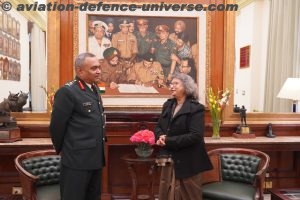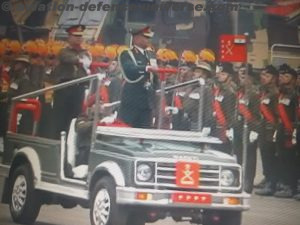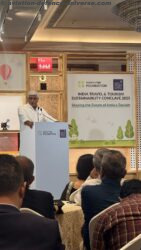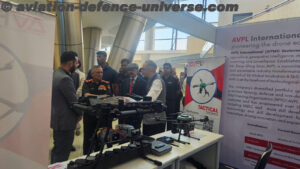By Maj Gen LB Chand, VSM (Retd.)
 New Delhi. 14 January 2024. “A Strong Military is the one that can intercept and interpret, at will, the communications between the sensors, decision makers and the shooters.” In today’s context of continuum of wide-ranging spectrum of conflicts and wars nothing can be more vitally relevant. There is a continuous clash amongst adversaries as well as allies. The objective is to retain / attain position of leader and retain dominance in geo-strategic, economic, political and social domains. Since the last decade of 20th century ‘Technology’ has become the catalyst, inciter, inhibitor and enzyme in the 21st century cauldron of international relations, geopolitics and world order. Like in the era of nuclear power struggle and the bid to dominate and control its proliferation era of Information Technology, Artificial Intelligence and Robotics the race is on to be the leader. Denial of niche technology, both hardware and software has become an important weapon in the hands of a few. Unlike the arms race, resultant divide due to denial of technology; which is cent-percent dual use, has become both a concern as well as a national strategy. “Aatma Nirbharta” in electronics and software has become a yardstick to measure a country’s progress and development status. Though important, this aspect needs detailed and exclusive discussions. It suffices to highlight that India is at the tail end in the field of R&D in electronics and embedded firmware. Irony is that while our share in world’s electronics R&D, production stands at 3.8% India is one of the largest electronics market of the world. The main pillars of Digital Power are: –
New Delhi. 14 January 2024. “A Strong Military is the one that can intercept and interpret, at will, the communications between the sensors, decision makers and the shooters.” In today’s context of continuum of wide-ranging spectrum of conflicts and wars nothing can be more vitally relevant. There is a continuous clash amongst adversaries as well as allies. The objective is to retain / attain position of leader and retain dominance in geo-strategic, economic, political and social domains. Since the last decade of 20th century ‘Technology’ has become the catalyst, inciter, inhibitor and enzyme in the 21st century cauldron of international relations, geopolitics and world order. Like in the era of nuclear power struggle and the bid to dominate and control its proliferation era of Information Technology, Artificial Intelligence and Robotics the race is on to be the leader. Denial of niche technology, both hardware and software has become an important weapon in the hands of a few. Unlike the arms race, resultant divide due to denial of technology; which is cent-percent dual use, has become both a concern as well as a national strategy. “Aatma Nirbharta” in electronics and software has become a yardstick to measure a country’s progress and development status. Though important, this aspect needs detailed and exclusive discussions. It suffices to highlight that India is at the tail end in the field of R&D in electronics and embedded firmware. Irony is that while our share in world’s electronics R&D, production stands at 3.8% India is one of the largest electronics market of the world. The main pillars of Digital Power are: –
- Infrastructure – IT Infrastructure and infrastructure supporting IT (Power, Transportation, Pure Air & Water).
- Manufacture – Hardware to build and sustain storage, transportation and protection of data.
- Raw Material – Degree of labelled digital data and quantum of digital data. Though least glamorous yet most challenging – it is the fuel for AI.
- Fully formed Systems – Expert Systems, Generative AI & Robotics.
- HR – AI skill sets R&D, data scientists / analysts and AI capable processors / chipsets.
- Policies – Privacy, Data Protection, ICT & Cyber, Responsible use of AI etc
- Laws – National and International to regulate and govern ethical and responsible use of technology and AI.
Communication Systems (ICT & Cyber) are the entry tickets to a Modern Digital space. In the absence of a reliable, robust, omni-present and secure ICTEC info-structure (Information Communication Technology, Electronics and Cyber) modern digital space would be as far as Mars and beyond. Since most of the readers are likely to be those related to Defence and National Security my paper is focusing on Defence ICTEC and how are we placed the 7 pointers of ICTEC mentioned earlier.
Early 20th Century.
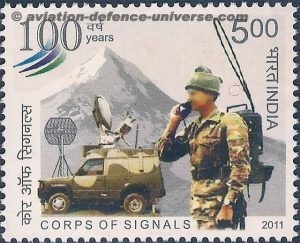 Corps of Signals was carved out of the Royal Engineers Corps on 15 Feb 1911. Signals were the prime agency that catered inter-services linkages and inter-connects. Operation Administration and Management of Service specific communication resources and infrastructure was the responsibility of respective service. In respect of communications, Indian Air Force primarily focused on the Air Traffic Control, Air Defence, Command and Control of Air assets. The dependence was on erstwhile Post & Telegraph lines, Tropo-scatter (technology of 1950s) and wireless radio communications. Formatted data was transferred over these low capacity mediums. Indian Navy on the other hand owned HF / VHF/ UHF and VLF radio systems. Their home-land needs were catered to by the P&T. Indian Army too depended upon Wireless Radio (HF/ VHF/ UHF), Radio Relays, Tactical line like JWD and Carrier Quads. For terrestrial communications the dependence was on P&T systems and hiring of P&T owned PL routes. At operational level PL resources were held by the Signal Units. The communication systems were more than adequate to meet the operational and logistic time lines and pace of the battle then.
Corps of Signals was carved out of the Royal Engineers Corps on 15 Feb 1911. Signals were the prime agency that catered inter-services linkages and inter-connects. Operation Administration and Management of Service specific communication resources and infrastructure was the responsibility of respective service. In respect of communications, Indian Air Force primarily focused on the Air Traffic Control, Air Defence, Command and Control of Air assets. The dependence was on erstwhile Post & Telegraph lines, Tropo-scatter (technology of 1950s) and wireless radio communications. Formatted data was transferred over these low capacity mediums. Indian Navy on the other hand owned HF / VHF/ UHF and VLF radio systems. Their home-land needs were catered to by the P&T. Indian Army too depended upon Wireless Radio (HF/ VHF/ UHF), Radio Relays, Tactical line like JWD and Carrier Quads. For terrestrial communications the dependence was on P&T systems and hiring of P&T owned PL routes. At operational level PL resources were held by the Signal Units. The communication systems were more than adequate to meet the operational and logistic time lines and pace of the battle then.
1980s and Beginning of New Millennium.
Till late 60s Indian National security concerns were internal security and protection of immediate borders. India’s neighbours too had primary notional interests of safeguarding their territory and internal security. The Area of Interests and Areas of Influence were dictated by their Force’s capabilities and reach. In the context of the world, geo-strategic interests of the bi-polar world and its allies remained the force that governed the force structuring of Nations. Competition between the Allies and Axis to dominate the world saw rapid advancements in defence technologies for Land / Air and Sea. Race to develop an atomic bomb followed by race to dominate space (Moon lander, space stations and satellite constellations) opened the flood gates in Defence Niche Armament. ICT systems to command, control and manage were mostly a step ahead in meeting the OAM needs of these Defence Systems. Computer Technology explosion since 1980s made C3ISR, C4ISR, NCW, Effect Based Operations, IW a reality. The world literally changed from Analog to a Digital world.
In Indian Context – 1971 Bangladesh war; which was a historic victory unparalleled post WW2 victory projected India and brought her into the radar screen of as an emerging power. Since Buddha smiled in the deserts of Pokhran on 18 May 1974, India was permanently in the Watch list of world power. India was placed on technology ban list of the west. Looking back into the past, this was a blessing in disguise for Defence ICT industry of India. Ms BEL Ltd and Ms ITI Ltd the two Defence PSUs developed and operationalised ICT systems at tactical as well as strategic level. AREN Family of Tactical Systems and ASCON Pan India Strategic Network became the exclusive Army owned systems. Long delays, because of denial of technology due to sanctions imposed on India compelled Indian Army to field a system that though considered state-of-the-art in 1970s to mid1980s was standing at the gates of obsolescence as far as operational requirements of digital battle space of 1990s was concerned. The drawback of AREN and ASCON Ph-1 was that networking technology in both was obsolete and it did not support networking (IP, Frame Relay, ATM) and high bandwidth of voice, data and video. To be fair on the efforts of BEL and ITI, their systems are still in use and unmatched in their ruggedness.
Technology, as has always been the case still drives and shapes how wars are going to be fought. Internet, Cloud, AI, Robotics, computing power on top of a palm, digitisation and weaponisation of space has brought about a paradigm shift in war strategies and battle drills / procedures. ICTEW is the thread that interconnects all in an integrated battle space.
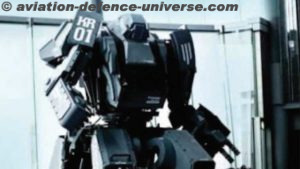
Isn’t it time to have not just an integrated theatre commands but an integrated ICTEW? AI assisted SLAs, Cyber Security, Data Security in a fully integrated Defence Network is the urgent operational need. Layers of ASCON, AFNet, Indian Navy’s Network Centric Network exclusive to each service in theatre are doomed to fail in an Integrated theatre. These networks need to be seamlessly interconnected at Physical, Networking, transport and IP layers. The data security and sharing can be easily and safely done at application layers with stringent authentication, authorisation, SLAs and end-to-end secure networking routes. NFS, ASCON Ph-4, NEWN, AFNet & its upgrade are all deploying the technology that is capable of achieving all of the above. Policies, Rules and Laws need to be jointly arrived at. Let us hope this is achieved before it is too late.
Modern Digital Battle field ICTEW Systems.
Time tested numeric force superiority, mainly boots on ground/ air/ sea needs a De novo assessment. Let me explain.
- In digital battle space two myths exist. One, induction of computer based automation will reduce manpower. Two, Generic AI and robotics will replace a person behind machine. Both of these are accessorial assets and best suited for routine/ repetitive tasks, operate in dull / dirty/ dangerous environment, analysis of vast volumes of data and above all relive persons after a hard fought battle as part of re-organisation phase in tactical battle.
- Numeric superiority ratios in terms of warriors, firepower during the assault phase remains unchanged. In modern battle field the numeric superiority is a sum total of automation, GenAI, Robotics and an ICT infrastructure connecting all these into one integrated C3ISR and Op-logistics systems. The ratio of man-machine and autonomous decision & weapon system still remains unclear.
- In a nutshell before an assault (kinetic or non-kinetic) is launched the Area of Interest has to be kept under continuous surveillance. During assault; planning, preparation of battle space and assault would be human intensive. Post success of assault re-org & resuscitation of HR and continued ISR and op-logistics will be GenAI and robotics heavy. Interestingly, in modern world of cyber, augmented / virtual reality, and intercontinental reach of missiles and autonomous weapon platforms not only the entire globe but the near and outer space is an area of interest. Augmented reality and GenAI combination are the Mahabharat’s Sanjay; bringing the battle field view into the operation rooms and National Command Posts. The prominence of ICT in the battle space has become a decisive factor.
Restructuring of People, Procedures and Processes.
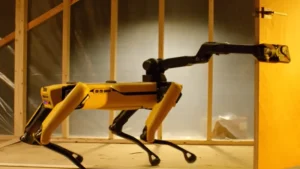
China and USA are in a technology race. Going by the trend, China may be the leader in Technology world order. Modern tech, just like the past, is a dual use technology. It just needs customisation and hardening to make it effective in battle space. Lessons learnt by USA, Russia, Allies and China in their journey of technology development road map and its deployment in various battle fields are invaluable information for India to plan and roll out the path. Confining to scope of this article and my area of expertise, I will spell out the issues as relevant to Indian ICT. Some important aspects are: –
- Integrated battle in digital battle field can’t be fought let alone won in Modern Digital Battle space. Integration has to be not only across the physical networks, but in entire ICT, namely; Data Centres and repository, cloud, service. Exclusivity to be in the application layers, command and control of resources OAM, allocation and tasking.
- Strong AI assisted authentication, authorisation and access mechanisms to ensure data consistency, integrity, confidentiality, security and privacy to be implemented to build trust and faith in not only data integrity but its safety.
- Single agency to manage Defence ICT infrastructure. The choice should be purely based upon the capability, expertise and skilled resources. Going by the models of USA, UK, Australia, France, Germany and China Signals is the preferred choice. A word of caution, creation of a three star appointment in HQ IDS will only be performing a staff role with no operational assets in direct command.
- India is emerging as a regional power. However, it shares borders with adversaries with whom India is in a state of No War No Peace. Until our land borders are safe its security will be Numero Uno. CPAF therefore, need to have networked communications with the Defence Forces in their AORs.
- Implementation of ICT infrastructure is time consuming. The short life cycle and Moore’s Law further complicates ICT development. ICT infrastructure development is a continuous cycle of install, repair, upgrade and replace. An inevitable expense.
- Cyber space needs 24×7 minute to minute watch and action. Merger of cyber assets is essential requirement. The managers have to be experts from both civil and defence forces. A question arises, do we customise the time tested effective models of USA, UK and Australia or do we create a new model? Currently, India has a fragmented and disjointed Cyber Information Security Organisation. My fear is that National CISO may be a technocrat with limited exposure to Cyber in Digital Battle Field, where the implications can be catastrophic for a nation. And of course, a duplication of organisation and underutilisation of expertise and resources.
Where are We and Way Forward.
Indian Armed Forces have been treading the path of C3ISR and C4ISR since mid1980s. There has been some success, but it has not reached the desired levels of effective usability in Modern Digital Battle Field. In Indian Army’s context ASCON, NFS, ICN, MCCS (LTE / 5G), TCS etc are major advancements in ICT. However, support for Command and Control as well as information transportation for analysis, assimilation and sharing across various platforms is still a major challenge. One of my major concern is that piecemeal procurement of stand-alone subsystems should not become an integration nightmare. Indian Army has deployed many Autonomous systems along the active borders. Absence of infrastructure, less high Band Width ICT infrastructure along the borders that can be extended across is a major deficiency. SDR with MANET capabilities at 1 or 2 Mbps is just adequate at section / platoon level or its equivalent. 5G or LTE are good solutions but have a major drawback when required for green field deployment. It is a difficult financial choice of ab initio unutilised deployment vs meeting operational timelines of a contingency that may not arise at all. Satellite constellation is a good option but the decision dilemma is in terms of balance between numbers of Low Orbit launch on demand satellites vs permanent constellation. The ICT infrastructure deployed along active borders is capable of meeting the requirements of low intensity conflict. However, with respect to China with heavy troop deployment and no-resolution of conflict in sight it would be foolhardy to not deploy ICTEC infrastructure that supports digital battle that PLA is capable of launching. To go by the information available in open domain and the emergency procurements listed in MoD web, Indian Army has deployed many new digital systems for ISR. They now need to be connected into a common ODDA loop. Dependence on IDDM and Make-2 procurement methodology will be one or two generations behind. These don’t offer the desired flexibility to the commanders deployed on ground. The way forward can be summed up in one sentence. Bring about not just jointness but secure need based automatic interconnect between ICTEC infrastructure.
Recommendations.
- Nation al Level – In my personal capacity as a person who was part of the team that implemented ASOCN Phase-3, CDNSS of Tac C3I, Data Centre, NFS, EW and HQ IDS (JCES), lead rep of MoD in ICTEC in many discussions I have observed that distribution of tasking is mainly based upon industrial age principle of division of labour. No decision is taken at higher HQs unless it is unanimous or ordered by the GoI. A separate chapter on ICT in DAP 2020 updated in 2023 still has not had the desired impact. Atmanirbhar Bharat and its enforcement in ICT procurements is a stumbling block for ICT of Modern Digital World. Any system that uses processors and chips has a substantial component of embedded firmware. In ICT systems this is even more pronounced. Open Source systems, contrary to the majority view of being safer have a major disadvantage of vulnerability management. Patch management and version consistency continues to be a pitfall. In view of this my recommendations at national level are: –
- Infrastructure Development – Complex state of the art systems or modules must follow a system of import core technology (kernel of the system) from trust worthy supply chain. The peripheral sub-systems can be designed and developed in house.
All imported cores must have a security wrapper built around it to ensure that the operational logs generated conform to a routine pattern. Any exceptions raise a security risk flag.
- Organisational Level Changes – The complete organisational chart needs a de novo look. Take a verified model and customise it to suit our needs. USA, UK, Australia have evolved their Org structure after decades of implementation experience. It is still being fine-tuned. Indian Organisation must be based upon on one of these tried and tested models. My study would recommend Australian organisational structure for the primary reason that Australian Experts who formulated ICT Policy of Australia are advisors of USA and UK.
- Policies – To be honest after studying the AI task force report of MoD as well Ministry of Commerce, I was a bit disappointed on the thoroughness of these reports. Even the on “National Strategy for AI #AIforAll” prepared by Accenture for NITI Aayog fell short primarily because the lessons and challenges faced by Countries who have almost a three decade lead in AI research and development was not translated into a suggested Road Map to bridge the already existing technology divide.
- Defence Forces Level – Defence AI Council (DAIC) headed by RM is being constituted. Defence AI Project Agency (DAIPA) was vide DDP’s order issued on 01 2019. Certain key AI products and technologies under development by DPSUs and OFB were listed. The Outcome is an MoD’s AiDef publication that presents AI preparedness of the Country in Defence. This booklet is more a listing of 75 AI Products. The strategy, AI organisation, roadmap, AI infrastructure development are yet to be listed. One tends to wonder whether DAIC is adequately equipped to undertake this task. It is recommended that :-
- Strategy – Formulate a combined Military Use AI strategy that focuses on Technology forecasting, its development, matching technology and requirements of a Modern Digital Battle. And create a Task Force of Defence, Industry and Academia.
- Funding – Allocate substantial funds for AI algorithm and AI Infrastructure development out of National Research Fund. Produce of these should be made available for civil use as applicable.
- HR and Skill Sets – Substantial steps have been taken to introduce AI in graduate courses run in military engineering colleges. An AI institute that offers exclusive PG and Doctorate Research course in AI, Robotics, data science and related field must be set up. The institute should be akin to IITs and AIIMS. Hence may be appropriate to name it “All India Institute of AI and Robotics” – a one stop shop of AI. These facilities can be made available both military and civil.
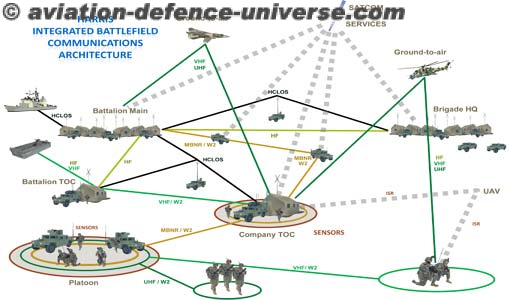
Conclusion
Patting one’s back for small achievements is motivating at entry level. For advanced users the impact at national level is important. Time must be spent to work out a detailed and realistic doctrine of AI and Robotics. The infrastructure and organisations must be raised and a clear road map with budgetary support must be put in place. Digitisation of data needs to be done on a war footing. Once this is achieved, Data scientists and AI experts are capable of rolling out AI products in record time. Most of analytics based AI project can be commercialised in a record time of 3 to 6 months. Even for an integrated systems (robotic arms / (semi) Autonomous and AI) development and production time is just about one year plus.
(Maj Gen L B Chand, VSM, Retd is a retired Corps of Signal Officer. As Project Director of ASCON he setup the ASCON Phase-III network. He has been associated with design and test-bedding of communications for Indian Army Tac C3I systems. The views expressed are personal. He can be contacted on editor.adu@gmail.com)







































